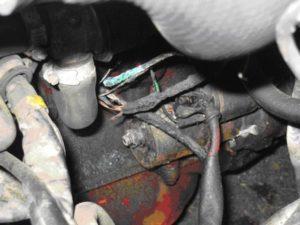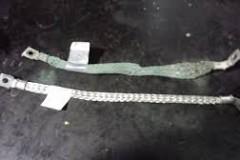AMP plugs and mass: It's the little things that make it happen to him
The most authentic electrical connections are those that use eyelets. For example, the voltage regulator, the ignition coil (s) and instruments then have threaded ends of usually M4 or M0. Just a finger of acid-free Vaseline along. The relevant plug eye over it. Eating ring on it. Nut on it. Ready. But not for thirty or forty years.
Nothing is forever
From the XNUMXs, the industry started to work with sliding plugs. The best idea was incorperated from AMP. The AMP plugs worked fine. However, the longer they were in a reasonably humid place, the more oxides came between the compounds. These oxides provide transition resistances, heat development instead of electrical contact. A still underestimated devil is in the transition resistances and the mass of connections.
Soldering is better
It is best to switch on a new plug by soldering it. Do that with a soldering iron that delivers so much power that the soldering action is as short as possible. In this way, heating of too large a part of the cable - and thus the thermal load on the insulation - is avoided as much as possible. Use acid-free soldering fluid for soldering. Grease the new compound with acid-free Vaseline.
The second best way is therefore used the most. That is a choice from responsible laziness. The AMP slide plugs are offered at all fairs and at every hardware store. We will leave the specimens from the famous 'buckets'. They are made of inferior material. And that ensures that they cannot be squeezed properly with a good clamp.
The plugs are clamped around the stripped wire end with a professional pliers supplied or purchased afterwards. This may have been done somewhere in the past of our vehicle by squeezing the plug over the stripped copper core with a pipe wrench. Maybe even about a copper core that was not sufficiently brightened. And that is why we are now in trouble. The loose copper wires that make up a cable have been unprotected for years. For self-protection, each individual wire has put on a greenish oxide coat. And all that oxide has an insulating effect. Does not transmit power. Does generate heat.
Also take a look at the wire that is plugged in.
It is best to use cable with as many loose copper wires as possible. It is flexible and the most trouble-free. With repairs and hobby work you can come across everything from a massive copper core from the residential or industrial wiring to modern wiring with a limited number of copper wires.
A multitude of problems due to mass connections
However, many of our problems are due to a blocked drain, rather than a faltering supply. We are talking about mass problems. And that return line is important for the cycle.
The problems are the places where there are metal to metal connections. Or should sit. Between instrument holders and their confirmation. Between engine and chassis parts. Problems like that are nice to solve. They can often be found by drawing an external ground connection with a long piece of wire between, for example, a non-functioning rear light and the ground of the battery. That eliminates all further possibilities or difficulties. There is woven mass wire for sale at the automotive parts trade. Often complete to length with soldered eyes. If such a cable is laid to earth from the refusing part, make sure that there is a clear metallic connection and also use the jar of acid-free Vaseline. For the motorcyclists among us: it is very important that the steering head and front fork make mass. The ground connection between them is formed by a bed of grease-bearing ball bearings plus the counter cables. It is surprising how many inexplicable problems disappear when a ground connection is made between the fork and the frame.
Some cable diameters and their maximum allowable amperage
0,65mm2, max. 5 Amp., For, for example, relay control
2 mm2, max. 17-18 Amp. For, for example, headlights
6 mm2 - 7 mm2, 40-50 Amp. For the dynamo, for example
23mm2, 60 Amp, for the starter motor









The author of this article has invented a few non-existent wire thicknesses. In my work as a car electrician / electronic engineer from 1967 until my retirement, I only came across and used the wire thicknesses below
Common sizes are:
0,75 mm2
1,5 mm2
2,5 mm2
4 mm2
6 mm2
10 mm2
16 mm2
25 mm2
50 mm2
75 mm2
Well Ampjes, if you get the right delivered no significant problems. But oh, woe if those incredibly hard plastic coated ampoules are delivered; then you really have a problem.
Without mentioning any further names, there are suppliers who supply this crap and this means that your connections are at least ramshackle. It certainly doesn't make me happy, because I suspect that this so-called “quality stuff” just comes from China. Already had a number of disruptions due to this mess.
And no, I do not use hardware store pliers to pinch the stuff, but very good (professional) tools.